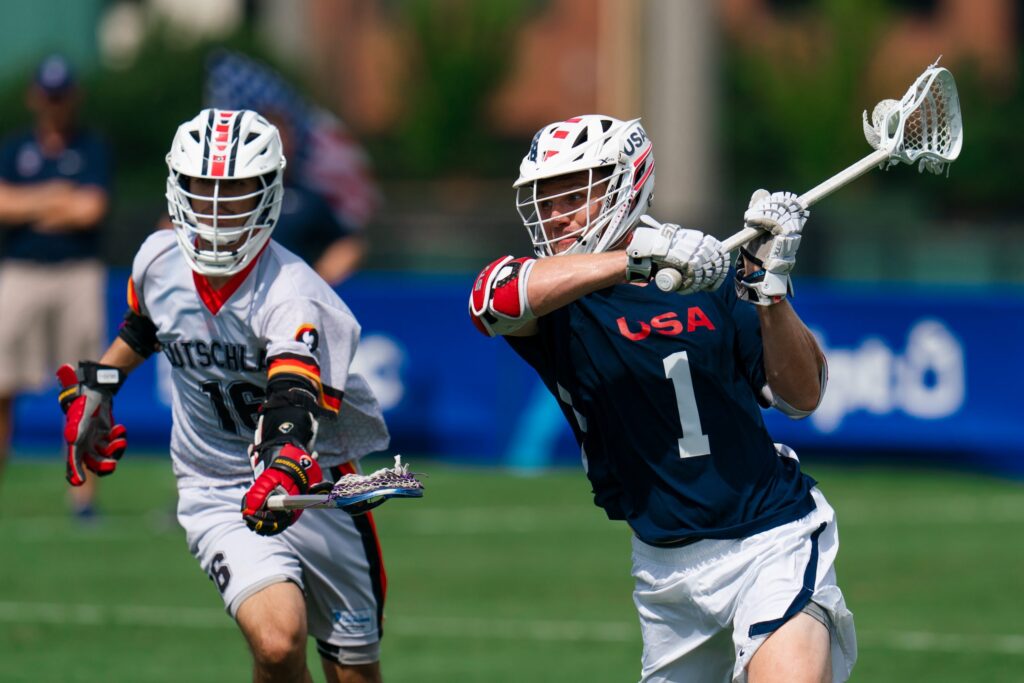
If you are new to lacrosse, you might not know the difference between field lacrosse, box lacrosse (also known as “indoor lacrosse,” or “Sixes” – the newest version of field lacrosse. Even if your child has tried lacrosse already, you may not know there are different versions of the game. HYL offers programs for each version of the game above – here is a quick description of each, to help minimize confusion as you continue to learn more about our sport:
- Field Lacrosse: this is the primary version of Boy’s Lacrosse played by HYL in the Spring (the official lacrosse season). It’s also the version of lacrosse played at the high school (for Varsity and JV Boy’s Lacrosse) and college level (Men’s Lacrosse). Field Lacrosse is played 10v10 on a large field (110 yds x 60 yds). In field lacrosse, teams typically have 3 Attackmen, 3 Midfielders, 3 Defenders and a Goalie on the field at the time. There are also specialty positions, such as “FOGO,” which stands for “Face Off, Get Off” – where faceoff specialists faceoff, then sub off the field; long stick midfielders (LSMs) – a midfielder with a 6-ft defense stick (teams are allowed four “long poles” on the field at a time – LSMs typically help win possession off faceoffs and help on defense, but typically sub-off for offense); offensive midfielders (sub-on for offense, off for defense in transition); defensive midfielders (sub-on for defense, off for offense in transition). The game has a lot of complicated rules that can take years to learn. There is a professional league called the Premier Lacrosse League that plays a modified version of field lacrosse from the late spring through the summer (they play on a shorter field, have a two-point line, faster pace-of-play, and more physical level of play, etc.).
- Box Lacrosse: box lacrosse, also known as “indoor lacrosse” is typically played indoors on a hockey rink covered with artificial turf. Box is played 6v6 – and due to the small field size (hockey rink size) and smaller goals (4’x4′ vs. 6’x6′ for field lacrosse), players need to be faster, make faster decisions and have advanced stick skills in order to score. There is also a professional indoor lacrosse league called the National Lacrosse League – and there is a local team called the Georgia Swarm that plays at Infinite Energy Arena in Duluth from the fall through the spring. There is not box lacrosse at the high school or collegiate level in the South, though there are some programs in the Northern states. The indoor game is dominated by Canadian and Native American players, who grow up playing this version of the sport. Indoor lacrosse is actually a national sport in Canada – and lacrosse originated with the Indigenous Peoples of North America, dating back hundreds of years.
- Sixes Lacrosse: Sixes is a NEW version of field lacrosse that was officially created in 2018 (though “small-sided games” – lacrosse with fewer players – has been played for much longer). The Sixes version of lacrosse was created in 2018 by World Lacrosse – designed to accelerate the global growth of lacrosse and to also create a version of the sport that required smaller roster sizes in consideration for Olympic inclusion. In 2028, Sixes will make its debut at the LA Olympics (lacrosse is now an Olympic sport – and “Sixes” is the version of the sport that will be played by countries competing for gold). In some ways, Sixes is similar to box lacrosse – but played outdoors. Rather than having multiple positions, Sixes games are played with 5 field players and a goalie. All field players are essentially midfielders and play both offense and defense. Many rules have been changed to create a more competitive environment for teams. For example, teams only faceoff to start each quarter (versus after each goal in traditional Field Lacrosse or Box Lacrosse. There are more frequent possession changes in Sixes as well, as teams get the ball after a shot, out of bounds, or shot clock expiration (giving both teams more opportunities to score). Sixes lacrosse is played with 6’x6′ goals like traditional field lacrosse, but there is a two-point line for long-range shots. There are several other differences, but these are the basics.
Why Should You Care About Sixes Lacrosse?
For starters, if you are a middle school player (or parent of a middle school boy), HYL will be adopting the Sixes Format for “Fall Ball” – our fall lacrosse season. We are making this change for several reasons, but the most important ones are:
- Smaller Roster Sizes: Sixes teams typically have 10-12 players (though they can have up to 15 on a roster our program). Smaller teams = more playing time for players. More playing time means more opportunity to develop skills, decision making, and of course, to just play the game.
- Local Competition: With smaller roster sizes, we believe we can have at least 3 teams of middle school boys this fall. This means we can compete locally this season and reduce the need for players/parents to travel long distances for games.
- Easier Format To Learn: The rules of Sixes are simpler than traditional field lacrosse. Players can learn the game faster (and parents can learn the game faster too).
- Did We Mention It’s An Olympic Sport?: Now that Sixes will be in the Summer Olympics, we believe it will be exciting for our players to try this format of the game that will be played at the LA2028 games. And who knows, maybe a current HYL player will represent Team USA someday? All Olympic lacrosse players have to start somewhere – and we think playing the Olympic version of the sport makes a lot of sense for your players.
- Transferrable Skills From Other Sports: Sixes has a lot of similar elements to the physicality of football, the offense/defense concepts of basketball, and game flow of soccer or hockey (to name a few sports). Players with experience in these other sports will catch-on fast with Sixes. And the skills players learn by competing in lacrosse will help them develop skills they can use to improve in these other sports as well.
How is Sixes Different From Field Lacrosse?
| FEATURE | TRADITIONAL FIELD LACROSSE | SIXES LACROSSE |
| Players on Field | 10 per team | 6 per team |
| Field size | 110 yds. x 60 yds. | 75 yds. x 40 yds. (may vary) |
| Offsides | Yes | No offsides |
| Faceoffs | Start of each quarter + after every goal | Only to start each quarter – clear after shots |
| Shot clock | College and Pro Only – no HS or Youth | 30-Second Shot Clock |
| Substitutions | On-the-fly | On-the-fly |
| Goalies/Defense | 1 goalie and up to 4 long-stick defenders | 1 goalie and 5 short-stick field players (no poles) |
| Olympic Format | NO | Yes – starting at LA2028 Games |
What To Expect As a Player or Parent
- More Action: Games are fast, with lots of scoring and constant movement
- Easier Entry: Newcomers can learn the basics quickly and start playing right away; experienced players will flourish
- Skill Development: Players get more chances to handle the ball, make plays and become more confident players
- Community Excitement: As Sixes gains momentum nationally and internationally, your child will already be participating in one of the newest Olympic sports (they will have a head start); local play will also generate more awareness and interest for lacrosse in our community (more opportunities for all our players)
Final Thoughts
Sixes lacrosse is designed to be fun, inclusive and accessible – perfect for our community as we work to continue to grow lacrosse participation at the youth, middle school and high school levels. We plan to expand our Sixes programs in seasons to come, but are excited to get our middle school boys started on their Sixes journey starting this fall! Whether your child is new to lacrosse or looking for a fresh challenge, Sixes offers an exciting way to play, learn and connect. We hope you’ll join us this fall as we embark on this journey to introduce our middle school boys to Olympic-style lacrosse. If you have questions or would like additional information, please feel free to reach out.
